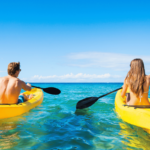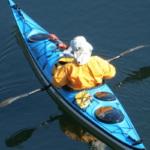Kayaking is an exciting and energizing outdoor activity that attracts adventurers and nature enthusiasts of all types. Whether you’re paddling through serene lakes, rushing rivers, or along scenic coastlines, understanding when the kayaking season starts is crucial for planning your trips. If you want to try something unique, analyze this article to find out what a kayak pool is. While kayaking can be enjoyed year-round in some areas, the ideal time to begin depends on several factors, including weather, water temperature, and regional climate.
In warmer states like Florida, kayaking season can start as early as March, whereas colder regions may not see the start of the season until late spring or even early summer. Knowing the start of the kayaking season helps you prepare for the right conditions—ensuring a safe and enjoyable experience, especially for beginners who might not be familiar with the challenges that come with colder waters or unpredictable weather patterns.
The timing of the season is not only about avoiding dangerous conditions but also about maximizing enjoyment. For experienced kayakers, the start of the season marks the opportunity to explore new routes and test skills, while for beginners, it’s the chance to begin safely and comfortably. This article will explore how the start of kayaking season varies across regions and what factors should be considered when determining the best time to start kayaking.
Factors Influencing the Start of Kayaking Season
The start of the kayaking season is not determined by a single factor but is influenced by various environmental elements. Kayakers must consider several variables to ensure that conditions are favorable for a safe and enjoyable experience. Understanding these factors will help you determine when the kayaking season starts in your area and plan your trips accordingly.
One of the primary factors affecting the start of kayaking season is the weather. Temperature plays a significant role in determining when it’s comfortable enough to be on the water. In warmer climates, the season might begin earlier in the year, as temperatures remain mild, while colder regions may have a delayed start due to freezing conditions. The availability of open water, free from ice or snow, is essential for kayaking to begin safely.
Additionally, water flow and river conditions are crucial considerations. High water flow can make kayaking more challenging and dangerous, particularly for beginners. Spring rains and snowmelt often cause rivers to swell, which may either shorten or extend the kayaking season depending on the region.
Factors influencing the kayaking season start:
- Weather conditions: Temperatures affect safety and comfort.
- Water temperature: Cold water can delay the season or require special equipment like wetsuits.
- River and water flow: Seasonal variations can lead to high or low water levels.
- Ice and snow coverage: In colder regions, the presence of ice can delay the season’s start.
- Location: Coastal regions may have a different season compared to inland lakes and rivers.
Apart from these natural factors, personal preferences and skill level also impact the decision of when to begin kayaking. Some kayakers may prefer to wait until water conditions are optimal, while others may be more adventurous and start earlier in the season, accepting the risks involved. For beginners, understanding these factors is even more important to ensure a smooth transition into kayaking.
Kayaking Season Across Different Regions
When it comes to kayaking, the start of the season varies greatly depending on the region in which you are located. In the United States, the kayaking season begins at different times in different states, influenced by geographical factors such as climate, terrain, and weather patterns. Understanding these regional differences is crucial for planning the best time to start your kayaking adventures.
In Southern states, like Florida, Texas, and Arizona, kayaking season can start as early as March or even February, when temperatures remain warm enough to be on the water comfortably. The mild winters and consistently warm weather in these areas provide ideal conditions for year-round kayaking. Many kayakers in these regions don’t experience the extreme weather variations that can delay the start of the season in other parts of the country.
However, in the Northeast and Midwest, including states like New York, Pennsylvania, and Minnesota, the kayaking season typically begins in late spring or early summer. This is due to colder temperatures and the presence of ice and snow, which need time to melt before water levels are safe for paddling. While the wait may be longer, the rivers and lakes in these regions are particularly beautiful during the summer months, making it a rewarding experience when the season finally begins.
In Western states like California and Oregon, kayaking can start as early as April depending on the region, with areas near the coast or in lower elevations offering earlier starts. However, higher altitudes, such as those in the Sierra Nevada, may have a delayed start due to snowmelt and colder weather conditions. Similarly, in Alaska, kayaking season doesn’t begin until late spring or early summer, as the waters remain frozen until the snow starts to melt. Each region offers unique opportunities and challenges when it comes to kayaking.
Kayaking Season Start Dates in Major US States
When planning your kayaking trips, it’s essential to understand how the season’s start varies across different regions of the United States. The timing can differ dramatically based on climate and geography, making it useful to reference specific start dates for kayaking season in various states.
Kayaking Season Start Dates in Major US States
| State | Typical Start Date | Notes |
| Florida | Early March | Warm weather allows early kayaking season. |
| California | Late March | Coastal and inland options open by March. |
| Alaska | June | Cold temperatures delay the season. |
| Colorado | April | Snowmelt impacts river conditions. |
| Washington | Late April | Mild climate but water temperatures remain cool. |
| Maine | Late May | Ice thawing and warmer weather open the season. |
Kayakers in warmer regions may enjoy an earlier season, while those in colder climates will likely need to wait for spring thaw and improved water conditions. The table above can help you understand the general trends, but local conditions may still vary. Make sure to check specific forecasts or local sources before planning your kayaking trips.
Best Time to Start Kayaking Based on Weather Conditions
The best time to start kayaking isn’t just about the calendar; it’s largely determined by the weather conditions in your region. For optimal conditions, you should aim for weather that is not only comfortable for paddling but also safe for beginners and experienced kayakers alike. When considering when the kayaking season starts, weather patterns are crucial in helping you plan for the right conditions.
Spring and early summer generally offer the best kayaking weather, especially in temperate regions. During this time, temperatures are mild, and the water is typically warmer, making it more comfortable for extended kayaking trips. In coastal regions, calm seas and moderate winds provide ideal conditions for ocean kayaking, while rivers in mountainous areas benefit from the snowmelt runoff, offering exciting rapids and steady flow.
However, there are some risks to be aware of. For example, spring also brings unpredictable weather with occasional storms, which can make water conditions hazardous. In addition, water temperatures are still cold early in the season, and paddlers may need to use wetsuits or drysuits to prevent hypothermia. In regions where kayaking season is delayed, it’s important to wait until the water reaches a safe, comfortable temperature for paddling.
The timing of your kayaking season will depend on what conditions you’re comfortable with. Whether you’re looking for calm, peaceful kayaking experiences on a lake or more adventurous paddling through rough rivers, the best time to start depends largely on the weather patterns in your specific area. Pay attention to local forecasts and always ensure that the weather is safe for kayaking before setting out.
Tips for Preparing for Kayaking Season
As you prepare to begin your kayaking season, there are several key tips that will ensure you are ready for a safe and enjoyable adventure. Whether you’re a seasoned kayaker or a beginner, taking the right steps before hitting the water can make all the difference. Equipping yourself properly and being aware of your surroundings is just as essential.
The first step is to check your gear. After months of storage, your kayak, paddles, and personal flotation devices (PFDs) should be thoroughly inspected for any damage or wear. It’s also a good idea to replace worn-out equipment before heading out on the water. Along with checking your gear, it’s important to refresh your skills if you’ve been away from kayaking for a while. You may want to take a refresher course or practice in a controlled environment before tackling more challenging routes.
For those paddling in colder waters, remember to pack appropriate clothing. Wetsuits or drysuits are necessary when water temperatures are low, as they help protect against hypothermia. Don’t forget to carry safety essentials like a first aid kit, whistle, and flashlight. Also, be sure to check local weather and water conditions before you go. Early-season waters can be unpredictable, so it’s essential to stay informed.
Tips for preparing for kayaking season:
- Check your gear: Inspect your kayak, paddles, and PFD for damage or wear.
- Practice skills: Take a refresher course or practice in calmer waters.
- Pack appropriate clothing: Wetsuits or drysuits are essential for cold water.
- Stay informed: Monitor local weather and water conditions before heading out.
- Safety essentials: Bring a first aid kit, whistle, and flashlight.
Preparing for kayaking season can make your experience more enjoyable and safe. Whether you’re hitting the waters for the first time or returning for another season, taking these steps will help you make the most of the upcoming adventure.
Conclusion
In conclusion, knowing when the kayaking season starts is a crucial first step for anyone looking to enjoy this exciting outdoor activity. While the timing varies based on weather conditions, location, and water flow, being informed allows you to make the most of your kayaking experience. Whether you’re paddling in the early spring warmth of Florida or waiting for the ice to thaw in the colder states, proper timing can ensure a safe, enjoyable trip.
It’s important to remember that kayaking is more than just an activity—it’s about connecting with nature, challenging yourself, and experiencing the outdoors in a unique way. By considering factors such as water temperature, river conditions, and seasonal variations, you can make informed decisions about when to begin your kayaking season. Planning ahead helps you avoid dangerous conditions like high water flow, freezing temperatures, or unpredictable weather, ensuring that your experience is enjoyable and safe.
Ultimately, the best time to start kayaking is when you feel ready and when conditions are suitable for your skill level. Early-season kayakers should start in calm, controlled waters to practice basic skills before progressing to more challenging environments. Experienced paddlers may take advantage of the early season for exploring new routes, while others may wait for peak conditions to maximize their enjoyment.





